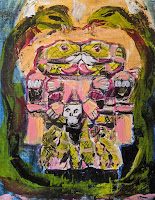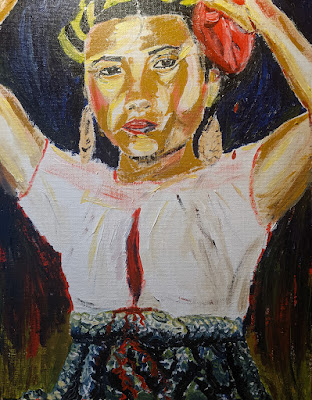As Easter approaches, so do thoughts of ritual sacrifice and rebirth. Lately, when I think of ritual sacrifice and rebirth, the first deity to come to mind is Coatlicue. She was worshipped by the Aztecs, but there is evidence that she predates the Aztecs. An ancient earth mother great goddess adopted by a conquering empire, Coatlicue was considered to be mother of the gods, the sun, the moon, and the stars. There are stories of Coatlicue being decapitated by her son Huitzilopochtli, the Aztec god of war. However, in another variant of the story, Huitzilopochtli doesn't decapitate his mother, he simply consumes her heart, "an act suggesting that she died as a result of heart excision, a common form of Aztec human sacrifice, according to colonial authors." Cecelia Klein pieces together evidence to argue that Coatlicue was one of the three goddesses (along with her sisters) from Aztec myth to sacrifice herself to give birth to and energize the fifth and present sun. In the story of the sisters' sacrifice, they are brought back to life via their skirts...Coatlicue's happening to be made of living snakes. This would explain why statues of Coatlicue have two snakes in the place of her head.
According to Klein, "Rather than dying as an enemy in battle, Coatlicue sacrificed herself voluntarily to provide the Mexica with the warmth, light, and changing seasons that brought them crops, food, and good health. If this reading of the Coatlicue statue is correct, women's powers to generate new life on every level were, among the Mexica, very great indeed."
According to Klein, "Rather than dying as an enemy in battle, Coatlicue sacrificed herself voluntarily to provide the Mexica with the warmth, light, and changing seasons that brought them crops, food, and good health. If this reading of the Coatlicue statue is correct, women's powers to generate new life on every level were, among the Mexica, very great indeed."
This conclusion is supported by the two major Mexica festivals at which Coatlicue was celebrated. At the spring festival called Tozozontli she was presented with "the first fruits of the flowers which had bloomed earliest that year" as well as "all kinds of flowers 'small, little, tiny, minute ones, no matter how many, no matter how little'." Then, each autumn, during a feast, "a woman impersonating Coatlicue was sacrificed."
Today's painting, available in the shop or through Fine Art America, commemorates Coatlicue's sacrifice and rebirth.
Sources:


Comments
Post a Comment